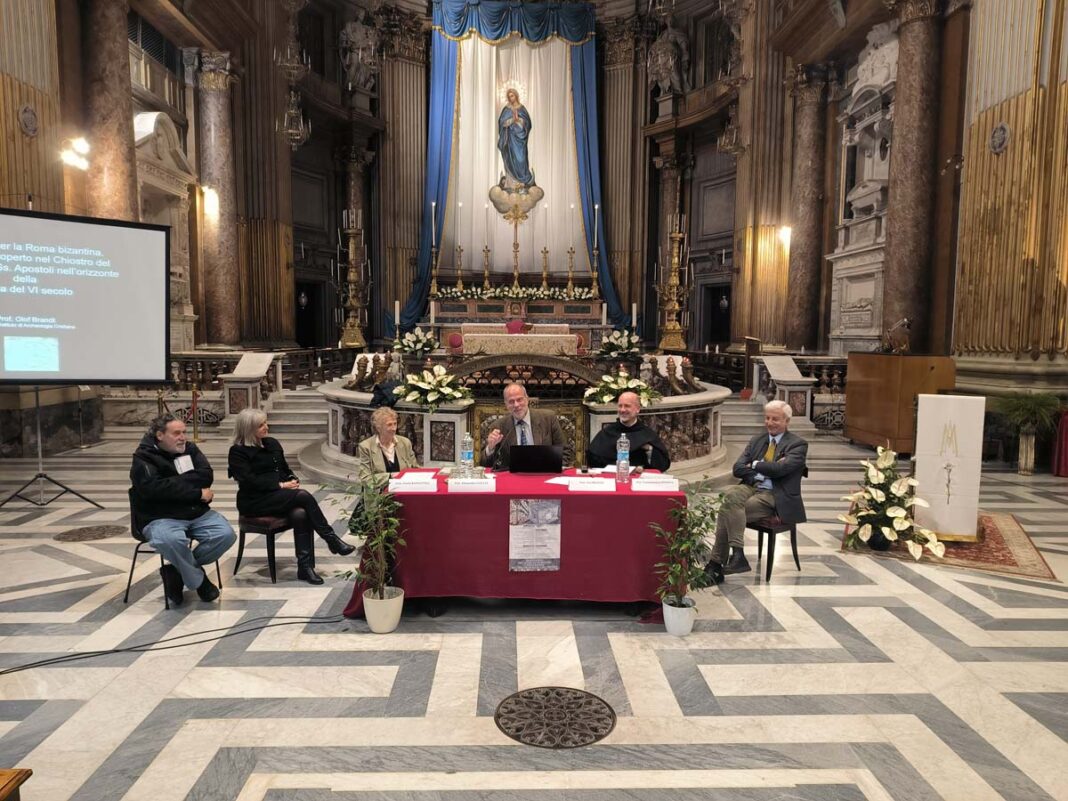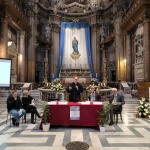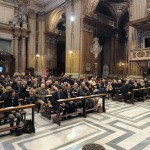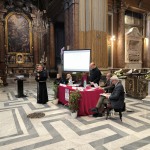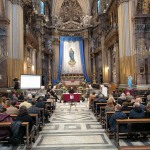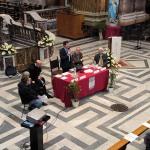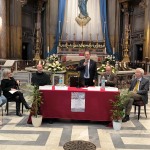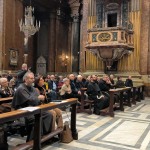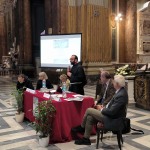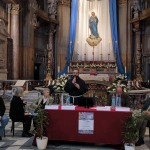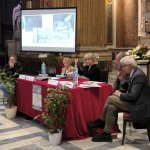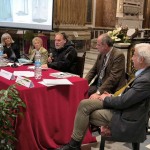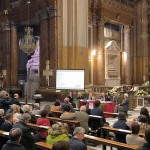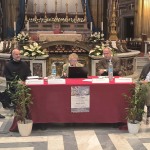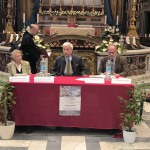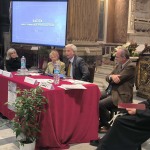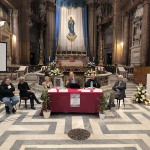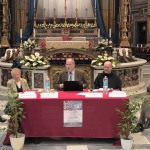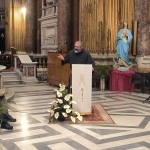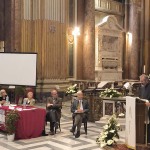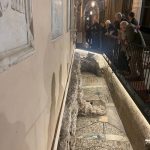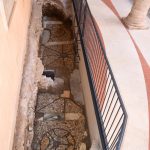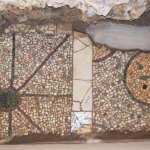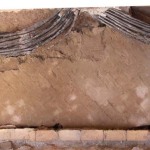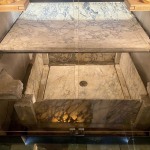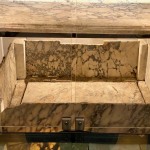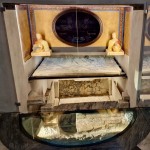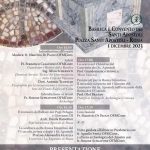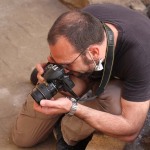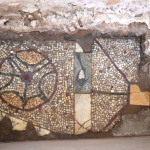During the afternoon of December 2, 2023, the Basilica of the Twelve Holy Apostles hosted a large audience of religious and lay people, including parishioners, students and specialists in art history and archeology. All were eager to learn about the new layout of the basilica’s original altar, which from antiquity had housed the relics of the Apostles Philip and James the Less. Moreover, the participants wanted to learn about the altar’s polychrome mosaic floor, which was recently discovered in the cloister of the friary.
This rather important event had been requested and promoted by Friar Francesco CELESTINO, the Pastor of the Basilica and the Guardian of the local religious community, to coincide with the Basilica’s annual Novena to the Immaculate Conception.
Friar Agnello STOIA led the visit to the altar and Friar Simone SCHIAVONE led the visit to the mosaic floor. Before the visits, two speakers helped frame these artefacts in the context of the Byzantine rebirth of Rome. The first speaker was Professor Alessandra GUIGLIA (La Sapienza University), a leading international expert in early medieval and Byzantine sculpture. She lectured on sculptural works in Byzantine Rome during the 6th century. The other speaker was Professor Olof BRANDT (Pontifical Institute of Christian Archaeology) who gave a detailed explanation on the flooring produced in Rome during that era. He shared the latest news taken from the doctoral research done by the author of this article, Friar Simone SCHIAVONE. Professor BRANDT is Friar Simone’s Supervising Professor. In addition, the professor outlined what may be the architectural layout of the first basilica, which was erected under Pope Pelagius I (556-561) and completed by his successor, John III (561-572).
The event began with greetings from the Vicar General, Friar Jan MACIEJOWSKI. Friar Francesco CELESTINO then spoke and urged the citizenry to look after this monument because it is part of its communal patrimony. Representatives were present from the organizations that authorized the restoration of the altar and monitored the archaeological excavation in the cloister, namely, Dr. Antonio TEDESCHI, from the Cultural Buildings Fund of the Ministry of the Interior and Silvio SCREPANTI, an engineer from the Governorate of Vatican City. Also present were those in charge of the scientific aspect of these projects, namely Danila BARSOTTINI, an architect with the Special Superintendence of Archaeology, Fine Arts and Landscape in Rome and Professor Giandomenico SPINOLA of the Vatican Museums, who described the executive process of both projects, their timing and the choice to involve specialists with particular professional and scientific expertise.
The presentations were moderated by the Procurator General, Friar Maurizio DI PAOLO, who outlined the history of both projects. He mentioned that altar project began in 2019, after a recognition of the relics of the Apostles had been commissioned by the then Pastor, Friar Agnello STOIA. Friar Maurizio also pointed out that the archaeological excavation in the cloister was promoted and carried out in 2021, by the archaeologist Friar Simone SCHIAVONE.
The altar was brought to light in 1873, when the architect Luca CARIMINI carried out a reconstruction of the crypt of the basilica, which had fallen into oblivion. The project to expand the setting where the altar was housed was directed by the architect Marco SETTI on behalf of the local Superintendency. The altar can now be better enjoyed thanks to the installation of an adequate lighting system. This precious altar, which is unique in terms of its features and large internal reliquary, was thoroughly and comprehensively cleaned. Its immovable base was reintegrated with its movable parts, namely, the slabs made of pavonazzo marble and corner pillars made of Carrara marble, which had been disassembled and transferred to a laboratory. This work made it possible to conduct careful graphic, photographic and descriptive documentation, revealing traces of modern tampering with the foundation screed and ancient graffiti (crosses, handwritten signatures and drawings) both on the table slab and on the vertical enclosing walls. The work also clarified the altar’s layout and how it functioned. It was, in fact, equipped with a front opening (fenestella confessionis) protected by a metal grate and closed by a gabled door, through which the faithful could see the sacred repository of the martyrs and lower a strip of fabric (brandea) into it to touch against their bones, thereby converting the fabric strip into an ex contactu relic.
The exploration in the cloister led to the discovery of an interesting mosaic floor eight meters in length, which symmetrically matched the one found in 1996 in the chapel of Cardinal BESSARIONE. Its tessellate pattern was divided into quadrants decorated with various linear and circular geometric motifs, filled with figures reminiscent of large rosettes. Its style matched the large-tile mosaic flooring found in Rome from the mid-6th century through the 7th century, as confirmed by a small number of attestations. The mosaic floor was interrupted by an opening in the middle containing a basin lined with red porphyry slabs. These may have held the relics of St. Savinus and St. Clement, as well as the colobion [tunic] of St. Thomas. The mosaic floor remained in use until the late 14th – early 15th century, when the floor level was raised on the orders of Pope Martin V Colonna. The pope authorized substantial renovation work on the basilica, which had been partly abandoned and disused after the 1349 earthquake.
Over the course of the fifteenth century, then, the flooring was redone three times. The last two levels can be discerned next to the masonry seat that runs along the apsidal curve and coincides with the time when the Friars Minor Conventual first arrived here (1463) At that time, the chapel was dedicated to St. Francis of Assisi and used for choral prayer.
It follows that finding the roots of the Byzantine Basilica Apostolorum Philippi et Iacobi at the Basilica of the Twelve Holy Apostles is a by-product of rediscovering the presence of the Conventual Franciscan family here, which for almost half a millennium has guarded the vestiges of a past that has remained largely shrouded in mystery, a past it hopes to reveal as soon as possible.
Friar Simone SCHIAVONE






